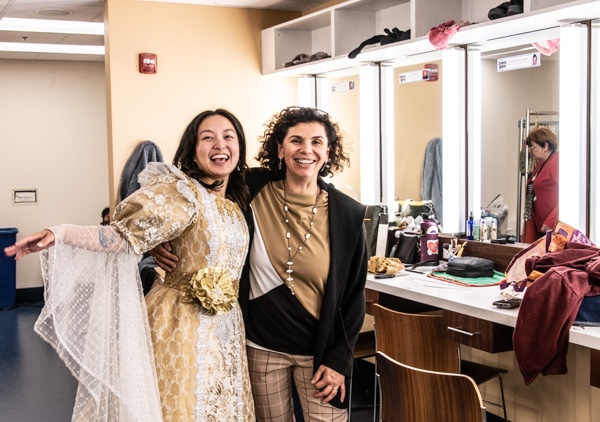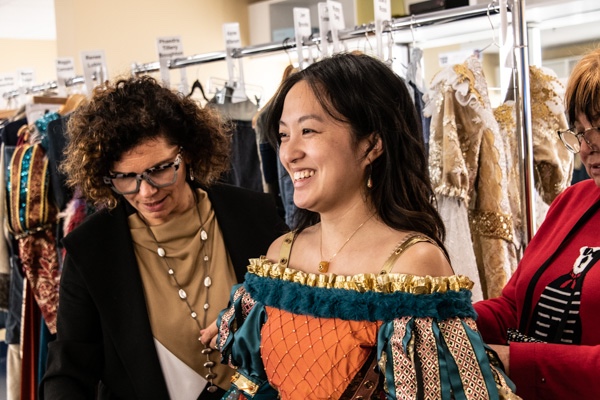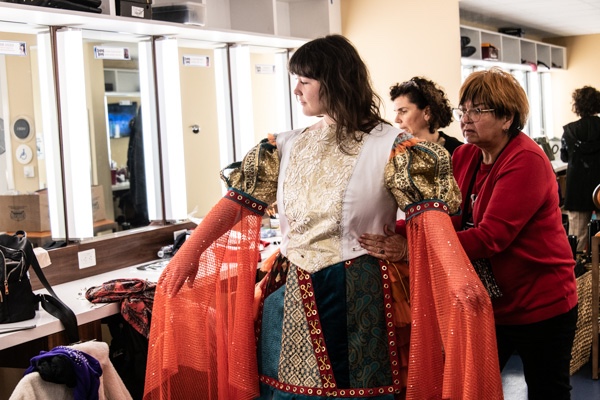By Courtney Coleman, MA Fashion Journalism
This holiday season, the Presidio Theater delighted audiences with a revamped edition of last year’s Panto show, Sleeping Beauty. The production infused a modern flair into the timeless classic presented in the traditional pantomime theater format.
Pantomime, or “Panto,” originated in the United Kingdom and gained popularity during the Victorian era, drawing inspiration from the 16th-century Italian comedy show, “Commedia dell’Arte.” Audiences were captivated by the “outlandish costumes” and themes rooted in popular culture, creating a lasting tradition of engagement with the audience through call-and-response interactions.
The production of Sleeping Beauty relates so much to San Francisco within the script. It portrays classic streets and iconic landmarks of the City by the Bay, such as Embarcadero, Powell St, or Fremont Street, through characters’ names. The audience will meet Embrakadero, a talking dog, King Powell, or Fremont, the Fairy. “We do hope it will become a holiday tradition for San Francisco – with different tales, of course,” said Peggy Hass, Executive Producer.

Alina Bokovikova, Costume Design coordinator at the Academy of Art University’s School of Fashion, has been designing the costumes for Panto shows since the first production at Presidio, the Magic Lamp, in 2021. The performance portrayed costumes with a more modernized Aladdin look. The styles mixed in denim with the luxurious silks in the pieces worn by Aladdin and Princess Jasmine. The sultan character from the classic tale transformed into the female role of “Sultana,” donning a black power suit with green, purple, and pink butterflies printed all over.
Inclusivity is a key value in Panto shows, having groups of all shapes, sizes, genders, and races to be represented in the play. The actor playing charismatic Hernia the Evil Witch, Rotimi Agbabiaka, is Nigerian and a part of the LGBTQ+ community. The costume of Hernia only elevated their display on stage. Alina Bokovikova and her team’s efforts in capturing the essence of each character are remarkable. Bokovikova gets all of her information from the playwriters Stephanie Brown and Richard Ciccarone, with the upkeep in the change of seasons, time period, style, and locations. In this rendition of Sleeping Beauty, the princess’ transition from baby to teenager is performed through a song called Needles, a playful twist on Amy Winehouse’s “Rehab”.
Alina Bokovikova has had a team behind her through this process of getting the Panto shows together. “Costume Design students from Academy of Art University helped in the production. It is very important for me always to have interns, students who help backstage, help actors with quick costume changes and everything.” Bokovikova’s assistant, Marisely Cortes, is an alumnus doing Panto for the third time. Patrick Wang, an MFA student, did fascinating craft work for this show last summer working at the costume shop. The entire wardrobe team is composed of students or alumni of Art U. This season, it’s alumni Jasmin Santiago and MFA student Beatrice Canete; last year, Yao Hy, Natalia Elliot, and Ting Xion had this amazing training working in the professional theatre.

So, in the aspects of potential costume changes, there were many opportunities for any being that stuck to the script and flow of play. When Princess Sonoma pricks her finger on a needle, the fairies come up with a plan to have everyone in the kingdom go to sleep with the help of the audience. The concept of the costumes was inspired by historical Medieval Times and knowing that they were working on the production calendar. Usually, starting costumes six months prior to technical rehearsals and designing the show in May/June. In July, the first script was altered, and mid-July, the construction of potential costumes started rolling. Then real costumes were 80% done when the actors were in rehearsal rooms because some actors would like to rehearse with pieces. “Sometimes costumes are a big part of acting, like a quick change for Hernia. We try to be prepared and get them out fast,” said Bokovikova.
It was a collaborative effort in terms of the inspiration behind costumes like Hernia, representing creative ideas from the director Liam Vincent, Bokovikova’s costume design, and Agbabiaka’s acting. The thoughts are going to account for the table of characteristics and features of the character. For Hernia, speaking with the production designers team for Satin in a castle with a twist of modernization. Finding some originality within this old story that fulfills the city of San Francisco. With that, it also rings true to what the actor can bring to the character.

In theater play costume design, many challenges emerge from how the show progresses. Everyone had to adapt to the new script, and that was seen every two weeks. Costume is one of the earliest stages of production, where the designer needs to understand the characters accurately. Within Panto, the impact of the costumes is intended to show off yet enhance funny moments. For instance, the audience’s favorites, the Chickens, bring up bursts of laughter from the audience when they lay eggs on stage or quickly change from black sneakers to red heels for certain scenes.
Panto is such an open-minded genre, and there is a constant cultural appropriation conversation surrounding this stage, making this play acceptable for all types of people. In the audience, seeing families of all demographics come to support. It leaves you thinking in your seat: how open-minded is everyone? “To have it sharp and interesting for all ages. And be sneaky so kids won’t get the adult jokes. And they will still be happy with lots of humor for children. Adults won’t be bored with children’s stuff but still get some laughs for their holiday show,” said Bokovikova.
Bokovikova and her team are already researching inspirations for next year’s Panto, meeting with playwriters and other members of the creative team to offer them ideas for moments when costumes can bring magic on stage.



